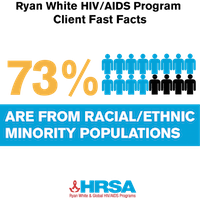
Day Two
Thousands of staff members from Ryan White HIV/AIDS Program (RWHAP) sites across the nation reconvened for the Day 2 plenary panel of the national conference to learn more about how social determinants of health (e.g., poverty, lack of housing) impact HIV care and treatment outcomes and how programs, policies, and individuals living can address these structural barriers to increase health equity. Below is a recap.
Role of RWHAP in Addressing Disparities
Heather Hauck, the HRSA HIV/AIDS Bureau Deputy Associate Administrator, outlined Ryan White client-level data demonstrating remarkable outcomes among RWHAP clients but ongoing disparities. Data show particular inequities in health outcomes for Black/African American gay men, youth, and transgender individuals.
Hauck noted that the RWHAP has “generally good outcomes,” as 81.4% of its clients have achieved viral suppression. As for addressing disparities, Hauck noted that the RWHAP is “in and of itself a structural intervention” and the “data tell us what we as a program collectively can do to utilize the RWHAP to improve health outcomes.”
Housing Matters
Brian Smedley of the National Collaborative for Health Equity provided data on the root causes of health inequity and how public health policy can help improve health equity. While many well-recognized factors impact health status, “where one lives” has an impact on health outcomes, Smedley said. He presented data on the degree to which residential segregation persists, despite well over a half century of progress in removal of legal and economic barriers. Notably, segregation patterns in select U.S. cities today are comparable to levels of segregation found in South Africa in the era of apartheid.
“Racial segregation concentrates poverty” by restricting opportunity, said Smedley, noting that nearly 10 million people in the United States live in areas of extreme poverty concentration, most of whom are Black/African American. Potential solutions include place-based strategies (investments in communities, including increased food options and improvements in the physical environment) and people-based strategies (investing in early childhood education and increasing housing mobility options).
The Data on the Impact of Unstable Housing
David Holtgrave from Johns Hopkins University summarized the goals of the "National HIV/AIDS Strategy: Updated to 2020" to reduce homelessness and housing instability for people with HIV (Goal 2), which is one of the few benchmarks not being met, and “actually going in the wrong direction.” To examine determinants of housing gaps among infected persons, Holtgrave provided a summary of a macrodata analysis of a subset of research studies, which revealed a set of consistent findings on the experiences of poorly housed individuals living with HIV. For example, 93% of studies found that adherence was worse; 89% found worse health outcomes; emergency room usage was higher; and HIV risk behaviors were higher.
Holtgrave also noted that outcomes for housing-deprived individuals were worse across the HIV care continuum but significantly better for those having received HOPWA services. (Approximately 11.8% of RWHAP clients have temporary housing while 4.7% are unstably housed.) See Holtgrave's slides.
Holtgrave concluded with a set of observations on the policy implications. Among them, housing status is strongly associated with HIV medical care. Also outcomes, and housing is a promising structural intervention to stop the spread of HIV and improve the health of those most affected by the epidemic.
Workshops See Beyond Racism
DeAnn Gruber, Program Director in the Louisiana Office of Public Health, summarized health disparities in her state, where the HIV rate is seven times higher among Blacks as compared with whites. One approach taken in Louisiana was to secure funding to address disparities through Beyond Racism workshops. They were planned and implemented over a multiyear strategy of “undoing racism” sessions and planning.
The results were as follows:
- Strengthening of their recruitment and hiring process
- Enhanced staff orientations and training
- Creation of new staff positions to better serve LGBT populations
- Adoption of new language and methods for presenting data and reports targeted to providers.
